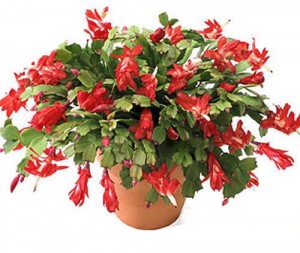Our staff here at Belle Fiori can’t believe it’s December already! We’re definitely keeping busy creating plenty of fresh new floral arrangements to distribute throughout the Milwaukee area this holiday season. Make sure to check out our online store if you’re thinking of decorating with a fresh centerpiece this season, or simply looking to spread holiday cheer to family and friends with a beautiful bouquet.
We hope to see many of you this holiday season, and until then, take a look at a great article from Purdue Horticulturist, B. Rosie Lerner about Belle Fiori’s December Plant of the Month, the Christmas Cactus!
Christmas cacti are not only popular holiday gift plants, but they are also the subject of frequent debate among gardeners. There appears to be much confusion about these unique tropical cacti regarding care, maintenance and, especially, on how to get them to re-bloom. The following tips address the most frequently asked questions.
We typically think of cacti as being heat tolerant, but Christmas cacti will keep their blossoms longer in cooler temperatures. Keep the plant in a well-lit location away from drafts from heat vents, fireplaces or other sources of hot air. Drafts and temperature extremes can cause the flower buds to drop from the plant before they have a chance to open.
Christmas cactus is a tropical type plant, not quite as drought tolerant as its desert relatives and, in fact, may drop flower buds if the soil gets too dry. The plants will wilt when under drought stress. Water thoroughly when the top inch or so of soil feels dry to the touch. The length of time between waterings will vary with the air temperature, amount of light, rate of growth and relative humidity.
The plant does not particularly need to be fertilized while in bloom, but most gardeners enjoy the challenge of keeping the plant after the holidays for re-bloom the next year. While plants are actively growing, use a blooming houseplant-type fertilizer and follow the label directions for how much and how often to feed.
While the Christmas cactus can adapt to low light, more abundant blooms are produced on plants that have been exposed to more light intensity. Keep your plants in a sunny location indoors. Plants can be moved outdoors in summer, but keep them in a shady or semi-shady location. Leaves may start to turn a bit red if exposed to excessive light. Too much direct sunlight can actually burn the leaves or may cause them to become limp. When it’s time to bring the plants back inside in the fall, slowly adjust the plants to life indoors by gradually increasing the number of hours they spend indoors each day.
If your plant tends to dry out and/or wilt frequently, it may be time to repot the plant into a slightly larger container. Well-drained soil is a must for Christmas cactus. Use a commercially packaged potting mix for succulent plants or mix your own by combining two parts plain potting soil with one part clean sand or vermiculite.
Pruning your Christmas cactus after blooming will encourage the plant to branch out. Remove a few sections of each stem by pinching them off with your fingers or cutting with a sharp knife. These sections can be rooted in moist vermiculite to propagate new plants.
Christmas cactus will bloom if given long uninterrupted dark periods, about 12 hours each night. Begin the dark treatments in about mid-October to have plants in full bloom by the holidays. You can place the plants in a dark closet from about 8 P.M. – 8 A.M. each night for 6-8 weeks or until you see buds forming. Christmas cacti will also bloom if they are subjected to cool temperatures of about 50 to 55 degrees F, eliminating the need for the dark treatments. Plants should be blooming for the holidays if cool treatments are started by early November.
Other species of holiday cactus bloom at different times of the year and have slightly different growth habits. Christmas cacti have scalloped stem segments and bloom at the stem tips. Thanksgiving cacti have 2-4 pointy teeth along the edges of the sections and will bloom earlier than Christmas cactus if left to natural day-length. Easter cacti have rounded teeth along the segments and bloom primarily in the spring but may also periodically re-bloom at other times of year.
-B. Rosie Lerner
Extension Consumer Horticulturist
Purdue University

